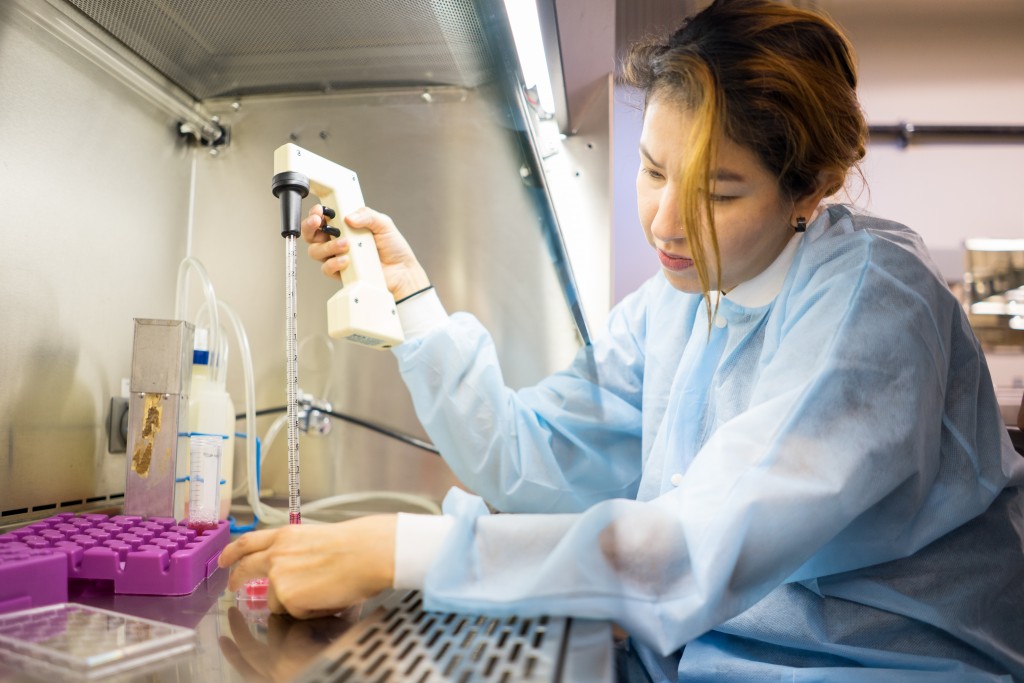Stem Cell Internship Open to City College Students

By Andy Bays
In the basement of Science Hall at Ocean Campus, in the former welding facility, City College students are learning to grow stem cells that may potentially cure diseases such as Alzheimer’s, stroke, Parkinson’s, heart disease and diabetes.
“Those little stringy things are stem cells,” Dr. Carin Zimmerman said, pointing towards one of the many microscopes in use. She is the coordinator of the Bridges Program at City College,
an internship for students who have earned a Stem Cell Technology certificate.
“Some are stem cells from hamsters and some are mice,” Zimmerman said. “The students learn how to grow the cells.”
The California Institute for Regenerative Medicine (CIRM), steward of a $3 billion bond measure (Proposition 71), allows students to get hands-on experience working in laboratories and with patients suffering from diseases. CIRM awarded City College over $2 million for the continuation of its five-year Bridges Program, which began at City College in 2010.
In addition to getting career experience, interns are given a monthly stipend of $2,700 to use for rent and other expenses while conducting their research.
“The internship is extremely popular,” Chief Communications Officer Don Gibbons of CIRM said. “It’s considered a triumph for students, patients and the emerging biotech industry.”
CIRM’s Mission
California Proposition 71 passed in 2004 in response to the Bush Administration’s refusal to fund stem cell research. In 2006, the state began funding “all areas of stem cell research that show promise to accelerating treatments to patients in need,” the CIRM website states.
“The underlying goal of the Bridges Program is to take students who might not have thought about a career in stem-cell technology and show them their options,” Gibbons said. “There’s no shortage of PhDs, but there is a huge lack of stem cell technicians.”
City College has received $2,704,836 from CIRM since 2010, which has funded 10 interns per year for five years.
Interns are expected to work 40 hours per week in a laboratory. A large percentage of the grant goes towards buying equipment like anti-contamination cabinets, incubators and large amounts of sterile plastic supplies made for one-time use.
The new CIRM grant of $2,163,500 has been assigned to cover the program’s expenses between 2017 and 2022. Beginning 2017, the number of interns accepted into the program will decrease from 10 to eight to improve the education of each student.
New direction
With the scheduled grant, the Bridges Program is aligning itself with the new direction in which stem cell research is heading.
“The first part of the Prop 71 money pretty much all went into basic research. Scientists just wanted to find out why things worked or how things worked,” Zimmerman said.
“Now we’re moving into what we call ‘translational,’ which is the idea that we’re translating from understanding how something works to using that knowledge to design a therapy or a cure to a particular disease,” Zimmerman said. “So now, (CIRM) wants the internships that they’ve funded through the Bridges Program to take a similar leap.”
Regarding the evolving internship program, Gibbons said CIRM is “emphasizing regular patient contact to help patients and giving the interns ongoing guidance in their careers.” Gibbons said CIRM is also increasing its focus on “the formal regulatory pathway and development process.”
The interns take a class on new FDA regulations, learn techniques for growing stem cells in a cost-effective manner and work with one of the approximately 800 Bay-Area biotech companies.
“The idea is to expose the interns to patients so they’re not just working on a lab bench without a full understanding of what’s happening,” Biotechnology Instructor Bob Del Vecchio said.
Del Vecchio said there are currently many breakthroughs in researchers’ understanding of how to put stem cells into people and cure things.
Internship challenges
Because stem cell treatments are at the forefront of cures for diseases, the emerging industry and the race to discover treatments are in dire need of technicians skilled in stem cell research.
City College became the first two-year college to teach stem cell technology in 2006, but the program is not without its challenges.
Crumbling infrastructure, occasional problems with hot water and heating, the college’s plan to downsize the number of classes, and the threat of having classes cut due to low enrollment are some of the major obstacles to the Bridges Program, Del Vecchio said.
“The hardest challenge is getting people to know about our programs,” Zimmerman said.
About 30 students per year earn the Stem Cell Technology certificate, a two-semester program with an enrollment cap of 40 students. Zimmerman said of the 30 who pass, about 25 usually apply for the internship, which currently accepts 10 students.
“One of the reasons we have a hard time filling all these classes is because people take one or two classes and get hired,” Zimmerman said.
Recent data released by City College said that students who earn the Stem Cell Technology certificate can expect to make between $27,300 to $50,500 per year working in the fast growing biotech industry.
“So, it’s good because that’s ultimately what we want,” Zimmerman said. “But, then, because there has been an explosion of companies doing stem-cell therapies and cures, and now that we understand enough that we can actually design these cures so they will work, and work efficiently, we need more people in the internship program.”
Contact a reporter
Send an email to: Andy Bays

Comments are closed.